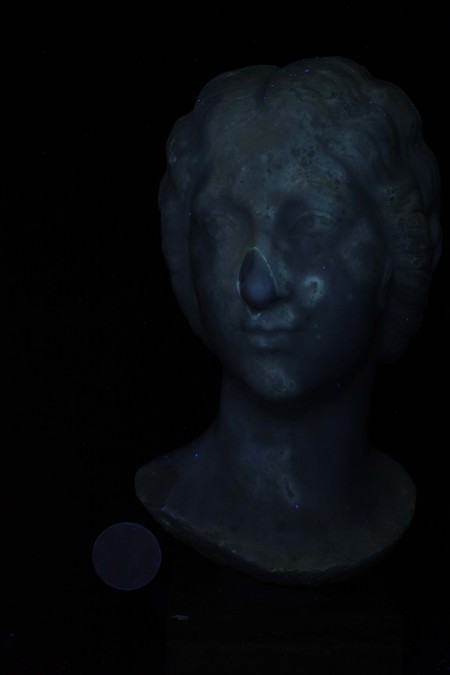Roman woman
Summary
On the face a single red grain was detected on the left cheek along with a few small grains in the left eyebrow. In the hair a larger number of red grains were detected in the incrustation and vegetation on the back of the head. The head has most likely received extensive cleaning in modern times.
Description of object
The shape of the neck indicates that the portrait was originally meant for insertion into a statue or more likely a bust.Chisels have been used to outline the hair as individual locks, finely carved directly into the marble surface. The chisel has also been used to shape the eyebrows and outline the eyes. The pupils are characterized by the running drill. The entire skin-surface has a highl-gloss polish finish. The tip of the nose is missing, but has been restored, but besides that the portrait is overall intact. The skin surface has few small scratches and cavities, and small and almost unnoticeable matt, slightly discoloured areas can be seen on the forehead and both cheeks. In the hair larger areas of thin layered, miscoloured incrustations covering the back of the head and parts of the neck are visible.
The surface bears signs of modern cleaning; with only minor traces of dirt on the back of the head and on the neck.
Choice of methods
Visual examination
- Macroscopic
- Microscopic in situ
Technical imaging
- UV
- VIL
Marble identification method
- Isotopic analysis
Visual examination
No traces of original colouring can be seen with the naked eye which is most likely due to extensive cleaning. The head was microscopically examined. On the face only one single red grain was detected on the left cheek along with a few small grains in the left eyebrow. In the hair a larger number of red grains were detected in the incrustation and vegetation at the back of the head.
Technical imaging
UV-FL: No fluorescence phenomena related to the antique polychromy, organic dyes or surface treatments are detected.
VIL: Only a few luminescent particles which could be Egyptian blue are observed in the hair n the back of the head.
Other types of investigation
Isotopic analysis was performed in 2000 in order to identify the marble. The results were an 86% chance of Parian marble and 71% chance of Haghios Minas and Mylasa marble.
Bibliography
F. Poulsen (1951), Catalogue of Ancient Sculpture in the Ny Carlsberg Glyptotek. Copenhagen, 499-500, cat. No. 717.
V. Poulsen (1974), Les Portraits Romains, vol. II. De Vespasien à la Basse-Antiquité, Copenhague, 157, cat. no. 158.
F. Johansen (1995), Catalogue. Roman Portraits III. Ny Carlsberg Glyptotek, Copenhagen, 86-87, cat. No. 33.
- IN 799
- Portrait
- End of the second century C.E.
- Roman Imperial
- Marble
- Acquired in 1887 from Count Tyszkiewicz through the mediation of Helbig.
- H. 37 cm.






